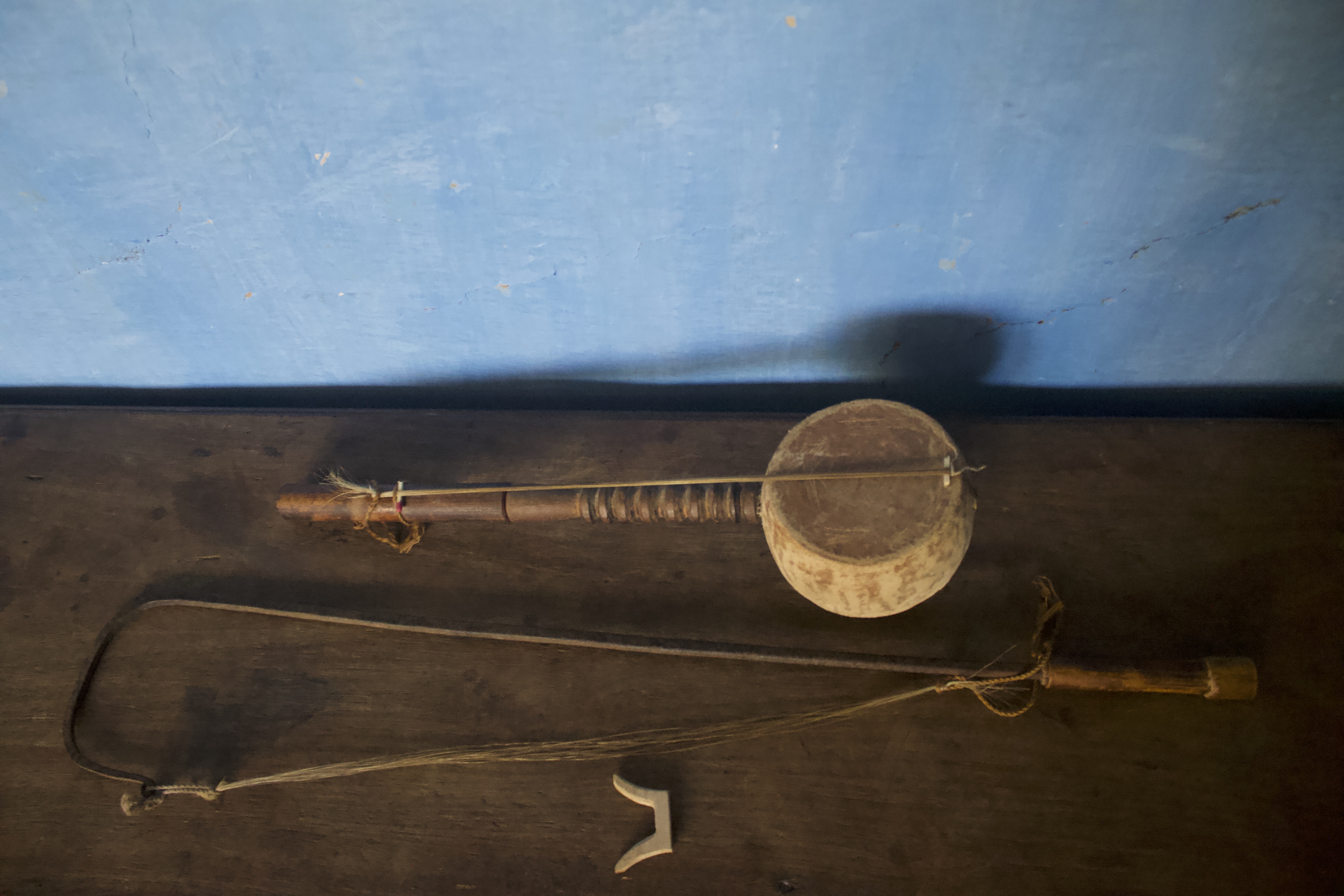He is 81 years old and is a practitioner of the nrah (cup violin), which he learnt to play and construct from his time in the khangchius (Ruangmei men’s dormitories). In this interview, Daimei recounts the days growing up in the khangchiu in his village of Thalluan where he learnt most of the songs of the Ruangmei Naga people and learnt to play the nrah.
Dormitories were an important sociocultural and educational institution for the Ruangmei people that enabled and allowed for the traditions, knowledge and way of life to be passed on to the youth of the village. Since there was no written documentation and script back in the day, everything was passed on orally and the dormitories provided a space where the Ruangmei elders could pass on knowledge to the younger people of community in the village. Ruangmei people were originally pantheist; with the advent of Christianity, the dormitory system and many traditional practices were discontinued and with it many of the folk songs, arts, and knowledge of the community were lost.
In this interview, Daimei explains the importance of the dormitories—khangchiu and liuchiu (women’s dormitory)—as centre of youth education, village participation, and the locus for the teaching and preservation of folk songs and other folk arts. He stresses on the importance of keeping the tradition alive and says that the youth must proactively take interest in pursuing the art forms and safeguarding all the traditions of the tribe.
Following is an edited transcript of the interview originally conducted in the Ruangmei (Rongmei) language on December 4, 2019, at the interviewee’s residence in Tamenglong town.
Kadiguang Panmei (KP): You spent some time in a khangchiu before you converted [to Christianity]. Could you please give us a brief note on the workings of and your time spent in these dormitories?
Namthiubuibou Daimei (ND): Yes, these dormitories play an important role in village and tribal life. There are dormitories in every village. The numbers vary from village to village depending on the population of the village. The men’s dormitory is called khangchiu and the women’s dormitory is called liuchiu or kailiu. Although the young men and women were chosen and recruited at birth for a particular dormitory in an auction-like function, they were inducted as members only when they attained puberty and as such there was no fixed age for when a person can join the dormitory. When a baby was born, the elder women from each of the dormitories would go to the home of the newborn and shout to claim the baby for their respective dormitories. If two or more dormitories claimed the baby at the same time during the gathering, the dormitory that got a chicken egg or any item agreed upon together by the concerned parties first to the home of the newborn, got to induct the baby as a member of their dormitory.
I was about 13–15 years of age when I was given membership to the khangchiu and I was a part of it for about four years before I converted to Christianity. These dormitories were like schools and I learnt about the ways of the tribe and collectively worked with the other members and dormitories for the village. We were educated and disciplined here and were taught the customs of the tribe. Here, men and women learnt different skills and trained in different fields. The young men and women learnt how to dance, play music, sing songs, and learnt the social customs and stories of their ancestors and participated in developing and keeping the village clean.
The women learnt traditional weaving and other skills and carried out certain roles like foraging, cooking, etc., whereas the men took part in learning the [musical] instruments, construction labour, hunting, guarding the village, and other tasks.
Members of both khangchiu and liuchiu together took part in various festivals and functions. In one such ritual festival, baanruh [the feast of merit/celebration of prosperity], which the entire village attended, the members of all the dormitories came together to help in the celebrations, and sing songs as part of the processions and help construct the taraengvkai (traditional ceremonial house).
Every village had a different number of khangchius and liuchius/kailius based on the population of the village. In my village there were four each with about 10 people in each. Some of the dormitories were more popular and had more members. The khangchius were karu thangmei kangmei [people from the upper side], kaphai mei kangmei [people from the side curve], kachung kangmei [people from the middle], and nkhamliang mei kangmei [people from the end of the village]. The liuchiu/kailius were karu thangmei kangmei liuchiu/kailiu, kaphai mei kangmei liuchiu/kailiu, kachung kangmei liuchiu/kailiu, and nkhamliang mei kangmei liuchiu/kailiu.
KP: What kind of songs were taught at the dormitories?
NB: The songs we were taught were songs about our famous folk heroes like Gairianmnang lu, Kaguiyang lu, Hongnianung lu, and so on. Lu is a suffix that means song/music. Elders would come and sing songs to us at the dormitories and those who were interested would quickly learn it. The songs sung by our forefathers were based on themes of love, respect, bravery, pride among many others. They had a variety of songs that they sang on different occasions. I am talking about a time before my people converted to Christianity. Songs and music were based on themes and these themes were reflective of the kind of people we were and how we lived back in the day.
Most of these songs were sung during festivals and occasions that happened year-round, depending on the agricultural season. There were songs that were sung to describe the pride and valour of the tribe [khanglyan ti mei lu], songs sung before the sowing of the paddy [mazah lu], songs sung during the harvest festival [malianglu], during the village feast [baanruh lu, kai su lu, taraengvkai lu, etc.] and there were romantic songs, songs on love [lamluan lu], and so on. There were also poems like short songs sung to kids, similar to a nursery rhyme.
KP: You stayed at the dormitory for four years. During your stay at the dormitories, which songs would you say were the most popular and why?
ND: Mostly songs of love and songs of lamentation [majian lu]. Songs that detailed the romantic relations between men and women like Kaguiyang lu, Gairianmang lu, etc. were more popular at the time when I was part of the khangchiu. It may be so because at the time there was practice of polygyny [men with multiple wives]. If you had more wives, you were seen as braver, wiser, richer, more virile, and so on. Men from the dormitories would go over to the liuchius with their nrah and sing songs. Love songs became popular as they used to sing songs and serenade the ones they loved.
KP: What instruments were taught at the dormitories and when were these instruments used in folk singing?
ND: We had a few instruments that complemented our folk songs. We had the nrah, a stringed instrument made from coconut shell and horse hair, which I learnt to play and make from my time at the dormitory. The nrah that I use in front of you is the one I recently made. The nrah was the more popular instrument back in the day. Besides the nrah, we had alim [flute], nkhuangh [drum], syanmiw [gong], and syamtuaic [hand cymbals]. The first three instruments that I have mentioned have been indigenously ours, but the syanmiw and syamtuaic seem to have developed from external influence, especially that of the Kuki people. Instruments were used in particular occasions. Nrah was used in particular songs, like love songs, nrah lu [violin song] and in big festivities like baanruh [feast of merit] and taraengvkai processions.
KP: You learnt how to make the nrah during your time at the dormitory. Could you please explain what nrah is and how it is made?
ND: Nrah is a stringed instrument that is made from naturally available materials. It is like a simplified version of a violin. The main body of the nrah is a coconut shell, shaved, cut into half and hollowed out; a wooden neck is inserted into the coconut shell and it is wrapped in buffalo skin and left to dry. The second component of the nrah is the bow made of iron, and the third component is the removable bridge to raise the strings. The most important material that is scarcely available here now is the hair from a horse’s tail, required to make the strings for the body of the nrah and the iron bow. My nrah that you see me using is a bit shorter than the traditional nrah because I didn’t have enough horse hair. (Fig. 1)

KP: Women and men were taught different skills at these dormitories and performed different roles for the village. Were men and women taught the same songs and instruments or were there distinctions in their roles in music and folk songs?
NB: There was no difference in the songs taught to men and women but it was mostly the men who were taught and learnt the music instruments. It is not a restriction as such for women, it was just something that was not socially acceptable though not restricted. Women were not denied the opportunity if they wanted to learn and play an instrument.
KP: These dormitories were central to the functioning and collective participation of the people in village life. They were important institutions where oral traditions could be preserved and had a space to thrive. With the discontinuation of the dormitory system, what do you feel is the future of Ruangmei folk songs and music?
ND: We have lost a large part of our heritage and traditions because of our conversion to Christianity. My family also sometimes tell me to forget about our traditional folk songs as they feel it is unholy and not in tune with Christianity but for me our folk songs and music are an important aspect of who we were and an important aspect of our identity. Singing and listening to songs was a part of growing up where I learnt about the bravery of my forefathers, stories of love, the history of my people. The purpose of singing in the past may not have been to pass on knowledge, but I feel that our songs and music are now a gateway to understanding our past lives considering the context they were sung in and the themes they were sung on. Folk songs and music are now an important component of that way of life. Knowledge of the customs, traditions, practices, way of living and history of the tribe are now all left with the last remaining elders [who made the transition from traditional Ruangmei religion to Christianity]. Singing thus served a purpose more than revelry, it became a tradition rooted in the very social and cultural fabric of the tribe. These songs are a mirror to the way of the tribe in many ways. Our folk songs were reflective of the many social events of our tribal way of life; this art form is dissipating and needs reengaging with and a proactive involvement from the youth.












